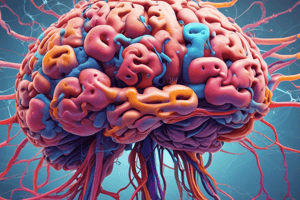Podcast
Questions and Answers
What primarily composes amyloid plaques in Alzheimer's disease?
What primarily composes amyloid plaques in Alzheimer's disease?
- Neurotransmitter receptors
- Beta-amyloid peptides (correct)
- Neuronal cytoskeleton components
- Hyperphosphorylated tau protein
What is the primary effect of hyperphosphorylated tau protein in Alzheimer's disease?
What is the primary effect of hyperphosphorylated tau protein in Alzheimer's disease?
- Formation of neurofibrillary tangles (correct)
- Enhanced microtubule stability
- Increased neuronal communication
- Reduction of oxidative stress
Which genes are associated with the familial forms of Alzheimer's disease through increased Aβ production?
Which genes are associated with the familial forms of Alzheimer's disease through increased Aβ production?
- MAPT and APOE
- BACE1 and PSEN1
- APP, PS1, and PS2 (correct)
- CYP and COMT
Which gene variation is recognized for its role in influencing the risk of developing sporadic Alzheimer's disease?
Which gene variation is recognized for its role in influencing the risk of developing sporadic Alzheimer's disease?
How does oxidative stress contribute to Alzheimer's disease progression?
How does oxidative stress contribute to Alzheimer's disease progression?
What role does inflammation play in Alzheimer's disease?
What role does inflammation play in Alzheimer's disease?
Which of the following factors is NOT involved in the mechanisms leading to Alzheimer's disease?
Which of the following factors is NOT involved in the mechanisms leading to Alzheimer's disease?
What is the impact of tau protein in Alzheimer's disease when it becomes hyperphosphorylated?
What is the impact of tau protein in Alzheimer's disease when it becomes hyperphosphorylated?
Flashcards
What is Alzheimer's Disease?
What is Alzheimer's Disease?
A progressive neurodegenerative disorder characterized by the accumulation of amyloid plaques and neurofibrillary tangles in the brain, leading to cognitive decline, memory loss, and behavioral changes.
What are amyloid plaques?
What are amyloid plaques?
Extracellular deposits primarily composed of beta-amyloid (Aβ) peptides, which are generated from amyloid precursor protein (APP) through enzymatic cleavage. Their accumulation disrupts neuronal function and promotes inflammation, contributing to neuronal damage.
What are neurofibrillary tangles?
What are neurofibrillary tangles?
Intracellular aggregates of hyperphosphorylated tau protein, which normally stabilizes microtubules within neurons. Hyperphosphorylation disrupts its function, causing it to detach and aggregate, interfering with axonal transport and neuronal communication.
How do mutations in genes affect Alzheimer's disease?
How do mutations in genes affect Alzheimer's disease?
Signup and view all the flashcards
How do genes like APOE affect Alzheimer's disease?
How do genes like APOE affect Alzheimer's disease?
Signup and view all the flashcards
How do oxidative stress and inflammation contribute to Alzheimer's disease?
How do oxidative stress and inflammation contribute to Alzheimer's disease?
Signup and view all the flashcards
How do environmental factors influence Alzheimer's disease?
How do environmental factors influence Alzheimer's disease?
Signup and view all the flashcards
How do genetics affect both familial and sporadic AD?
How do genetics affect both familial and sporadic AD?
Signup and view all the flashcards
Study Notes
Overview of Alzheimer's Mechanisms
- Alzheimer's disease (AD) is a progressive neurodegenerative disorder characterized by the accumulation of amyloid plaques and neurofibrillary tangles in the brain.
- These abnormal protein aggregates disrupt neuronal communication and lead to neuronal death, resulting in cognitive decline, memory loss, and behavioral changes.
Amyloid Plaques
- Amyloid plaques are extracellular deposits primarily composed of beta-amyloid (Aβ) peptides.
- Aβ peptides are generated from the amyloid precursor protein (APP) through sequential enzymatic cleavage by β-secretase and γ-secretase.
- The accumulation of Aβ peptides disrupts neuronal function and promotes inflammation, contributing to neuronal damage.
- Mutations in APP, presenilin 1 (PS1), and presenilin 2 (PS2) genes are associated with familial forms of Alzheimer's disease, often resulting in increased production of Aβ peptides.
Neurofibrillary Tangles
- Neurofibrillary tangles are intracellular aggregates of hyperphosphorylated tau protein.
- Tau protein normally stabilizes microtubules within neurons.
- Hyperphosphorylation of tau disrupts its normal function, causing it to detach from microtubules and aggregate into tangles.
- These tangles interfere with axonal transport and neuronal communication, further contributing to neuronal dysfunction.
- Mutations in the tau gene (MAPT) can cause familial forms of AD and are linked to earlier onset and more severe disease progression.
Genetic Predisposition
- Familial AD cases account for a small proportion of total cases.
- However, genetic factors play a role in sporadic AD as well, influencing susceptibility.
- Genes such as APOE, and additional genes are implicated in the risk of developing AD through various mechanisms.
- Variations in these genes influence Aβ metabolism, tau phosphorylation, and neuron resilience.
Other implicated factors in Alzheimer's Disease
- The role of oxidative stress and inflammation in neuronal damage and AD progression is increasingly recognized.
- Oxidative stress can damage cell components, including proteins and lipids.
- Inflammatory responses contribute to neuroinflammation, which is a feature of AD, resulting in neurons dysfunction.
- Environmental factors like diet and lifestyle may further influence susceptibility to AD by affecting the risk factors already discussed.
Current Therapeutic Strategies
- Current therapies primarily focus on managing symptoms and slowing the disease progression, rather than curing it.
- Some drugs aim to reduce Aβ accumulation and aggregation.
- Other approaches target tau phosphorylation and aggregation.
- Research continues to explore novel therapeutic targets and strategies.
Studying That Suits You
Use AI to generate personalized quizzes and flashcards to suit your learning preferences.





